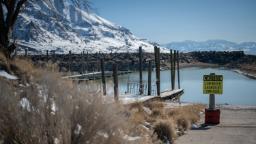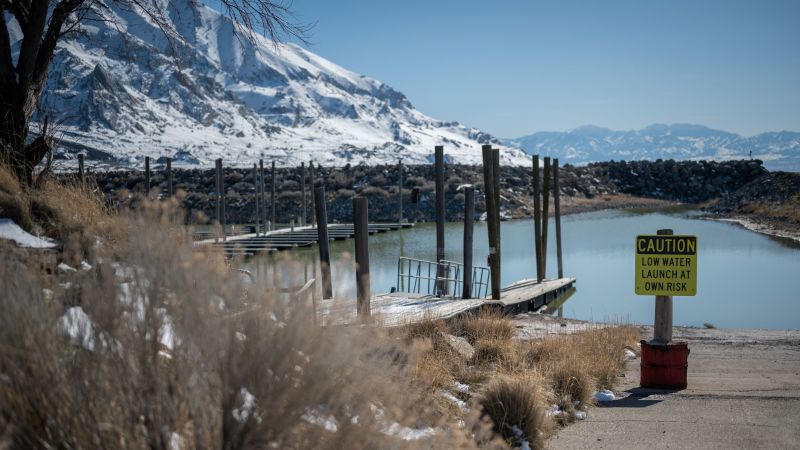
CNN
—
It was only three months ago that nearly three dozen scientists and conservationists sounded the alarm that the Great Salt Lake in Utah faces “unprecedented danger” – unless the state’s lawmakers fast-tracked “emergency measures” to dramatically increase the lake’s inflow by 2024, it would likely disappear in the next five years.
Now, after an incredible winter full of rain and snow, there is a glimmer of hope on North America’s largest terminal lake, where water levels had fallen to a record-low last fall amid a historic, climate change-fueled drought across the West.
As of Thursday, the snowpack in the Great Salt Lake basin was more than double the average for this time of year.
All of this winter’s rain and snow that fell directly into the Great Salt Lake increased the water level there by three feet. And while that “feels like an answer to prayers,” said Benjamin Abbott, a professor of ecology at Brigham Young University and lead author of the January report, experts have cautioned that one good winter is not enough to save the iconic lake.
In reality, the precipitation only made up for what was lost to last year’s drought and evaporation.
“Unfortunately, that doesn’t substantively change the timeline we described in our January report,” Abbott told CNN.
“If we play our cards right and shepherd more of the snowmelt to Great Salt Lake, this could buy us another two years. On the other hand, if we go back to business as usual, we could be back at an all-time low 18 months from now.”
To reverse the decline, the Great Salt Lake needs an additional 1 million acre-feet of water – roughly 326 billion gallons – per year, according to the January assessment.
Bonnie Baxter, the director of the Great Salt Lake Institute at Westminster College and one of the authors of the January report, said the state would “need another five years like this in order to get the system healthy again.”
“If I do the math, we got about three feet of direct precipitation that fell into the lake this year, that is fantastic,” Baxter told CNN. “But the last two years, we also lost 2.8 feet in the summer, and we expect to lose that three feet in the desiccating summer. So now, we’re pretty much even, and that’s not a good place to be.”
Climate change has been making it increasingly difficult for the Great Salt Lake to fully bounce back. As temperatures get warmer, Utah water officials say they have seen evaporation and depletion exceed the amount of water that’s making it into the lake.
Now conservationists are preparing for a nail-biting waiting game to see how much more water the lake could receive from snow melt. The melted snow would first need to be diverted to fill up the state’s reservoirs, before officials determine how much water the Great Salt Lake gets, Baxter said.
She also added she’s worried about the rate at which the snow is melting, underscoring that it’s important that the snow melts really slowly. As it trickles down the mountains, it should slowly make its way down creeks, recharge the aquifers and eventually fill the lake.
“But if it melts really quickly, which is probably going to happen because we have these late snows and now we’re right up against warm temperatures, then you get the water just rushing over the land and not taking time to charge the aquifers and just evaporating off the surface,” she said. “Then it seems counter intuitive, but less water will make it to the lake in that case.”
The impacts of the drying Great Salt Lake are already widespread. It threatens critical habitat for endangered species as well as the state’s economy. From the mineral industry to agriculture and recreation, the Great Salt Lake contributes $1.3 billion to the annual economy, according to a state assessment.
If the lake continues to dry up, the economic toll would range from $1.7 billion to $2.2 billion each year, the assessment concluded.
The rapid drying of the lake bed also exposes toxic dust that threatens human health. Terminal lakes, like the Great Salt Lake, are ones where water can flow into but not out of the basin. And when strong winds blow over a drying lake bed, they kick up tiny particles that can be inhaled and damage the lungs and exacerbate other respiratory illnesses. These pollutants have been linked to health complications such as asthma, heart disease and chronic bronchitis.
However, even with the much-anticipated snowmelt, Baxter said it still won’t be enough to save the lake.
“Say we get two more feet, that’s fantastic, but we’re still struggling to be where we want to be,” she said. “The way I think about it is this year buys us some time to work on some of these long term issues,” including water rights and installing meters so farmers know how much they are using.
Baxter, who has lived in Utah for 25 years, said this is the most snow she’s ever seen. But with the climate crisis creating a hotter and drier future, experts say the recent winter storms only got them a year or two to prepare.
Last month, the Church of Jesus Christ of Latter-day Saints agreed to donate some of their water shares to the state of Utah for the Great Salt lake, equivalent to more than 20,000 acre-feet, which it had historically used for agricultural purposes. Still, experts say the state needs to continue water conservation efforts across the board.
“We’re not going to be bailed out by excess snow,” Baxter said. “We’re hitting these pressures of climate change now. Mother Nature is not likely to cooperate with five landmark years, so to expect this to happen five years in a row, that’s not going to happen.”


